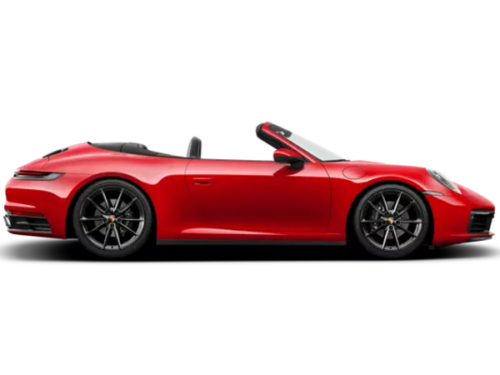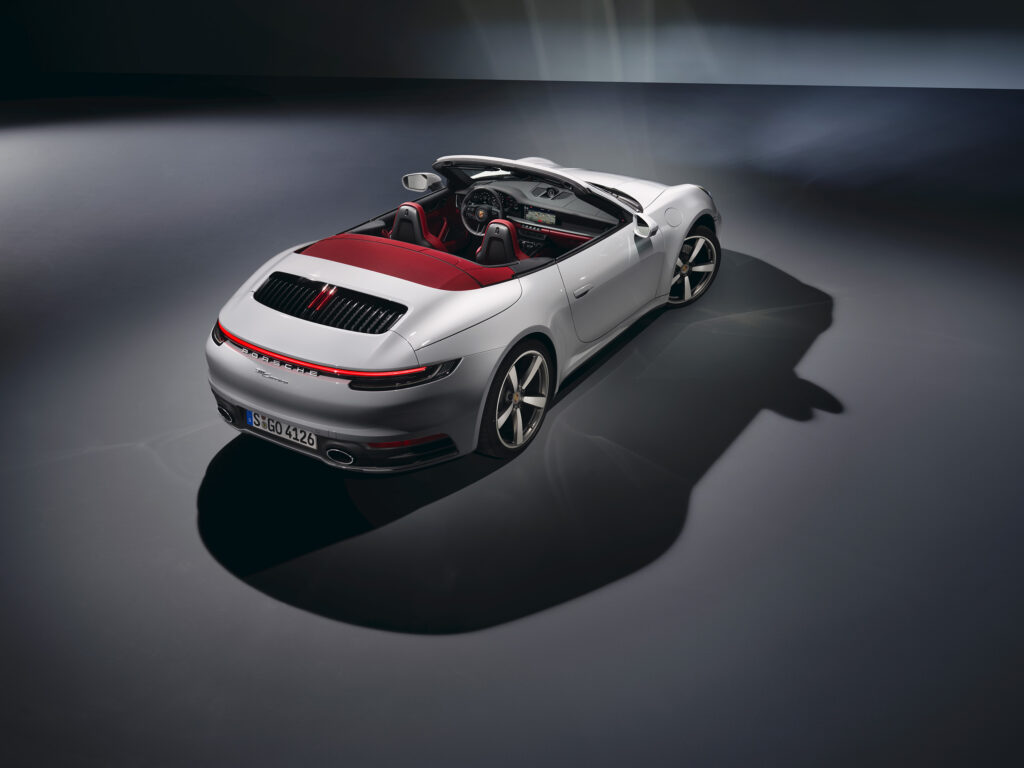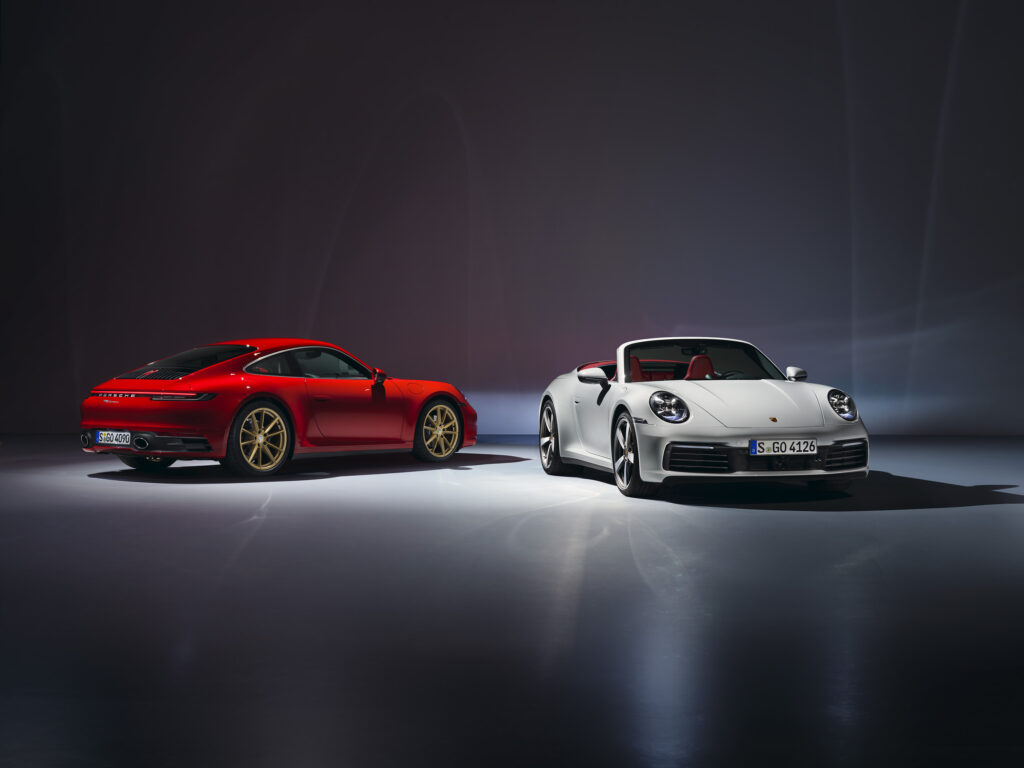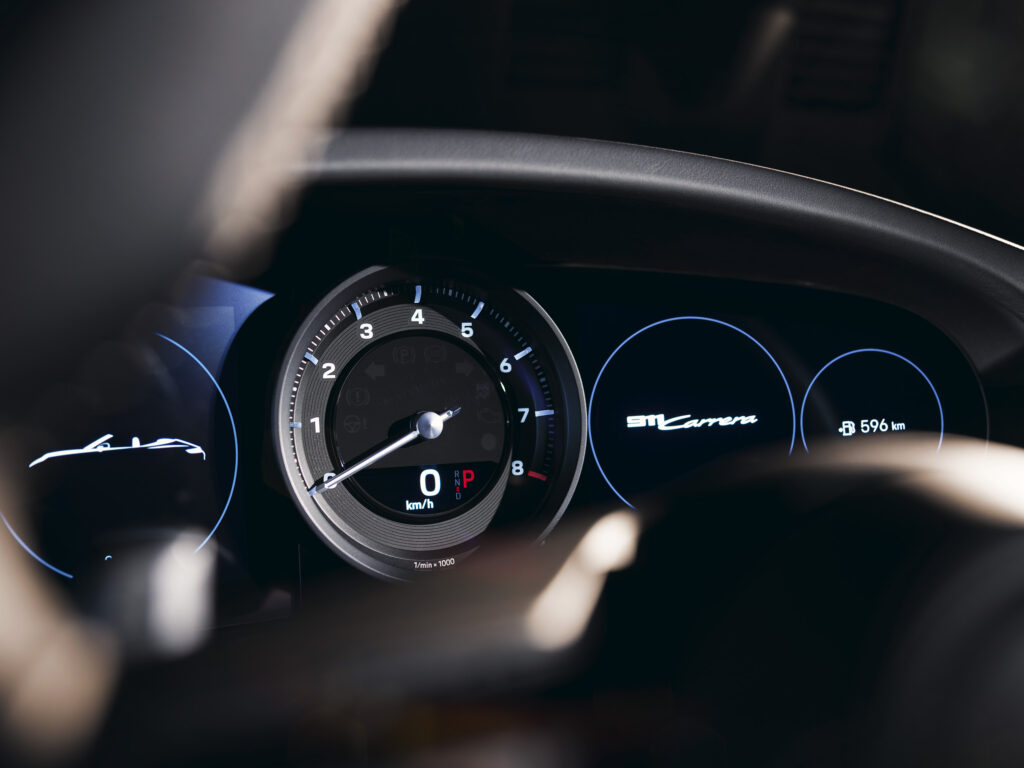2020 – 2024 Porsche 911 (992.1) Carrera Cabriolet – Reviews, Pricing, Specs & Buyers Guide
The 992-generation Porsche 911 Carrera Cabriolet is the open-air gateway to the modern 911 lineup: a daily-friendly, twin-turbo flat-six convertible with real back-road pace, long-trip comfort, and a roof system so well engineered that you can forget all your old “soft-top compromises.” For model years 2020–2024 (pre-facelift “992.1”), the base Cabriolet distilled everything that makes a 911 special—traction, steering feel, chassis polish—into a car you can enjoy with the sky showing. This guide covers the story, specs, performance, options, year-to-year notes, press reception, market realities, and buyer tips.
Where it fits: the story & mission
Porsche launched the 992 Cabriolet right alongside the coupe, emphasizing that the open car would drive like a 911 first, be a cabrio second. To that end, Porsche engineered a magnesium-bow fabric roof with an integrated glass rear window and a new hydraulic mechanism that opens or closes in about 12 seconds at up to 31 mph—a headline capability that set the tone for the car’s usability from day one. Under the skin, the 992 platform brought a stiffer mixed-metal body, wider tracks, and the latest PDK dual-clutch gearbox, plus the drivability of a small-turbo 3.0-liter flat-six. The Cabriolet’s promise was simple: 911 dynamics with roof-down freedom, no cowl shake, and minimal wind fuss—validated early by instrumented tests and first-drive reports.
Powertrain, chassis & hard numbers (base Carrera Cabriolet)
Engine & output (U.S. 2020–2024 base):
- 3.0-liter twin-turbo flat-six
- 379 hp @ 6,500 rpm, 331 lb-ft from 1,900–5,000 rpm
- 7,500-rpm maximum engine speed
- Integrated dry-sump lubrication; direct fuel injection
Transmission:
-
8-speed PDK dual-clutch (gear ratios 1–8: 4.89 / 3.17 / 2.15 / 1.56 / 1.18 / 0.94 / 0.76 / 0.61) with 3.99 reverse; final-drive/differential ratios as specified by Porsche.
Suspension, steering, brakes, tires:
- MacPherson-strut front; multi-link rear; variable-ratio electromechanical steering (~15.0:1 on-center, quickening to 12.25:1)
- Steel brakes (330 mm rotors with 4-piston fixed calipers), PCCB ceramics optional (410 mm/390 mm)
- Standard stagger: 235/40 ZR19 front & 295/35 ZR20 rear on 19/20-inch wheels
- Dimensions, aero, weight: L/W/H: 177.9 in / 72.9 in (w/o mirrors) / 51.1 in; wheelbase 96.5 in
- Cd 0.31
- Curb weight: 3,508 lb (U.S. spec, 2020 base Carrera Cab)
Performance (factory):
- 0–60 mph: 4.2 s (PDK) or 4.0 s with Sport Chrono launch control
- Quarter-mile: 12.6 s (12.4 with launch control)
- Top track speed: 180 mph
- EPA 17/24/20 mpg (city/highway/combined, 2020).
Those figures are for the base rear-drive Carrera Cabriolet—not the C4, S, or GTS. Porsche’s press announcement at launch repeated essentially the same numbers and underscored how close the cab is to the coupe in real-world pace.
Roof system & everyday usability
The panel-bow fabric top (with that coupe-like curvature) and the 12-second/31-mph operation are more than party tricks. They make top-down driving something you do in the flow of traffic, not only at stoplights. An electric wind deflector helps keep the cabin calm, and the roof’s glass window + magnesium bows prevent ballooning at speed. Multiple first drives and reviews praised the lack of cowl shake and the quiet, quick roof. Practicality is classic 911: a 4.66 cu-ft frunk and usable rear shelf/seats (reduced vs. the coupe because of roof packaging), cited at 5.75 cu-ft for rear cargo volume on the 2020 base Cabriolet.
How it drives: character & calibration
The base Cabriolet feels like a well-damped GT with sports-car reflexes. The small, quick-spooling turbos give eager mid-range shove; PDK keeps the engine in its sweet spot, and the chassis takes a set without drama. Early Car and Driver impressions noted no cowl shake and a remarkably compliant ride (even in Sport Plus), plus strong pace that likely outperforms Porsche’s own 0–60 claims in instrumented testing. Edmunds summed up the 2020 911 family as the benchmark all-rounder—“middle ground between touring and scintillating performance”—and gave the 992 high marks for polish even if some missed the older cars’ more mechanical soundtrack. The base cab inherits that vibe: grown-up refinement without losing the fun. Top Gear’s 992 Cabriolet review (updated during the run-out of 992.1) praised the roof’s speed and refinement and the car’s general “all-round talent,” even if a coupé still offers the sharpest edge for track heads. For everyday speed with sun and sky, the cab makes its case easily.
Options & packages that matter on a 992.1 Cabriolet
- Sport Chrono Package: Adds the dash mode switch, performance timers, and launch control. It’s what drops the base cab’s 0–60 to 4.0 s officially—worth it if you enjoy spirited driving.
- PASM / PASM Sport: Adaptive damping is excellent; -10 mm PASM Sport is road-dependent—great on smooth surfaces, firmer elsewhere.
- PCCB (ceramic brakes): Lower unsprung mass and stellar fade resistance; unnecessary for street-only use (replacement costs are high).
- Front-axle lift: Saves lips and sanity on steep drives and city life.
- Driver-assist & comfort: Adaptive cruise, lane keep, seat ventilation, heated wheel—popular on real daily drivers.
- Wind control: The integrated wind deflector is a quiet hero for top-down days; make sure any used car includes the factory piece and that it deploys properly.
Tech & infotainment (PCM 6.0)
A mid-cycle software enhancement arrived January 2022 for PCM 6.0, bringing a refreshed UI and (crucially for Android users) Android Auto integration on 2022-model-year 911s and newer. Earlier 992.1 cars run earlier PCM variants and won’t get full PCM 6.0 retrofits, per Porsche communications; check the exact software level on any used car you’re considering.
Year-to-year highlights (base 992.1 Cabriolet)
- 2020 (launch): Base Carrera Cabriolet debuts (RWD, PDK only). 379 hp / 331 lb-ft, 4.2 s to 60 (4.0 w/ Sport Chrono), 180 mph. New fast-operating roof (12 s @ 31 mph).
- 2021: Running changes minor; broader 992 range expands.
- 2022: PCM 6.0 update lands for 2022-MY cars (Android Auto, UI tweaks). The base cab’s power and core spec remain the same.
- 2023–2024: Lineup diversification around the base continues (T, S, GTS, AWD flavors), while the base RWD cab keeps the same outputs/figures pending the later 992.2 refresh for 2025-on. (Don’t confuse 992.2 Carrera headline figures with 992.1—this guide covers 2020–2024.)
Performance in the real world
Instrumented tests of close siblings (and Porsche’s own claims) suggest the base 992.1 Cab is quicker than it looks on paper with Sport Chrono/launch—especially in cool conditions and on sticky rubber. Even more telling, Car and Driver’s early drives found ride quality surprisingly compliant and body integrity excellent over broken pavement—key validations for a convertible.
Pricing, value & the market
At introduction, the 2020 Carrera Cabriolet carried a U.S. base MSRP roughly in the $110k–$112k range (before options/destination). Car and Driver quoted $111,550 for a base car at the time; dealer guides and launch write-ups matched the ballpark. By 2024, sticker prices rose across the 911 family as usual, and optioned cars can swing widely. If you’re cross-shopping used examples, spec, mileage, and condition dominate price more than tiny model-year deltas within 2020–2024.
Reviews: what the press said
- Car and Driver (2020 base Cab): “No cowl shake to speak of” and a ride “remarkably compliant even in Sport Plus.” Acceleration felt quicker than Porsche’s conservative claim.
- MotorTrend (2020 S Cab context): Called the new 992 Cab “ideal” for open-air touring thanks to performance and roof execution; posted a base/“as-tested” price snapshot for S-grade cabs typical of the era’s option swings.
- Edmunds (2020 911 family): “Expertly fills the middle ground between touring and scintillating performance.” The benchmark feel is intact.
- Top Gear (992 Cabriolet overview): Roof operation is “quiet and swift” at up to 31 mph, and the car’s all-round ability remains standout for a luxury-sports cabriolet.
Buying guide: what to look for on a used 992.1 Cabriolet
- Roof system & wind deflector. Cycle the soft-top multiple times—listen for odd hydraulic noises, confirm full sealing, and check the 31-mph in-motion operation. Verify the electric wind deflector deploys/stows cleanly. Replacement roof hydraulics and fabric are costly; proper function is table stakes.
- Wheels/tires & alignment. The staggered setup (235/40-19, 295/35-20) lets the car bite hard but can hide inner-shoulder wear. Check date codes and inner barrels for rash; look for clean, even wear and recent alignment paperwork.
- Brakes. Steel rotors are stout; if PCCB is fitted, inspect the rotor faces for chips and verify pad depth—street life is long, but damage is expensive.
- Software & infotainment. If Android Auto matters, target 2022-MY cars (PCM 6.0) or verify the exact PCM version and feature set. Porsche confirmed the 2022 update brought the functionality; earlier cars don’t generally get a full retrofit.
- Underbody & front fascia. Check for scrapes (especially on non-lift cars) and that under-trays are intact. Front-axle lift is valuable in cities and steep-driveway neighborhoods.
- Documentation & options. Sport Chrono is a value driver for enthusiasts (and unlocks the 4.0-sec 0–60 claim). Comfort options (heated/ventilated seats, driver-assist) matter for daily use. Window sticker/build sheet helps you price correctly.
Ownership experience
Driven gently, the base Cab is easygoing, quiet-roofed, and efficient enough for road-tripping. Driven hard, it’s still a 911—clear steering, trustworthy traction, and chassis balance that makes fast roads feel natural. Tires will be your most frequent consumable; rear wear can be meaningful if you enjoy launches and mountain passes. Routine service intervals mirror other 992s, and the roof system is robust when exercised and kept clean. The back seats are more “kids and bags” than adults, but they fold to create a surprisingly useful shelf—plus you still have a 4.66-cu-ft frunk.
Specs snapshot (base 992.1 Carrera Cabriolet, U.S. 2020)
- Engine: 3.0-L TT flat-six — 379 hp / 331 lb-ft
- Redline: 7,500 rpm
- Transmission: 8-spd PDK (ratios 4.89–0.61)
- Drivetrain: RWD
- Brakes: 330 mm steel (PCCB 410/390 mm optional)
- Wheels/Tires: 19″/20″ — 235/40 & 295/35
- Curb weight: 3,508 lb
- 0–60 mph: 4.2 s (PDK) / 4.0 s (with Sport Chrono launch)
- Top speed: 180 mph
- Cd: 0.31
- Cargo: 4.66 cu-ft frunk; 5.75 cu-ft rear (cab-specific figure)
- Roof: 12 s operation up to 31 mph
Verdict
If you want the open-air 911 experience without straying into ultra-high-price or track-day territory, the 992.1 Carrera Cabriolet is a sweet spot. It’s genuinely quick, luxurious enough to daily, and—thanks to that excellent roof—shockingly drama-free to live with. The base engine’s 379 hp is plenty, the chassis is pure 911, and the real-world ride/rigidity are better than many expect from a soft-top. Get Sport Chrono, pick the PASM spec that suits your roads, make sure the roof & PCM boxes are ticked to your liking, and you’ll have a convertible that does sunrise commutes and mountain-pass blasts with equal joy. In short: it’s the best kind of sensible indulgence.
What We Said At Launch
Removing the roof the car is supposed to have little impact on its chassis stiffness and curvy road prowess, but Porsche tells us that the current generation 911 cabriolet drives just as well as the coupe. We say, it is pretty close which is a huge achievement and we can make the case that the cabriolet 911 does everything so well that you should choose it over the coupe.
Just like last generation, Porsche offered the Cabriolet in Carrera S and Carrera 4S versions to start, and more recently gave us the Cabriolet GTS and Cabriolet 4 GTS versions too, in addition to the Turbo and Turbo S Cabriolet models. The current base cabriolet is built on Porsche’s new MMB platform like the rest of the 992 lineup. That means it will remain stiff even without its roof thanks to additional structural elements in the floor and firewall as well as the new engine mounts.
These new improvements allow Porsche to offer the Sports PDCC Chassis option. This was only offered on the coupe version of the 911 previously. Because the new Cabriolet is so stiff it can now handle the option. The 911 Cabriolet’s roof can go down in a quick 12 seconds. You can raise or lower it up to 31 mph, which is a nice feature. Porsche added magnesium structural elements to the drop top to keep it from ballooning at high speeds. When up, the car keeps the coupe’s overall shape well. If you drop it, the soft top folds down and has no cover, a feature typical for the brand.
Powering the base Cabriolet is the same impressive turbocharged flat-six engine that makes 379 bhp @ 6500 rpm and 331 ft lbs of torque. The base cabriolet can do the 0 to 60 mph run in 4.2 seconds flat. With the optional Sport Chrono Package that drops to 4.0 seconds. It sure sounds to me like you don’t lose much when you go with the 911 Cabriolet in terms of performance. You just gain the option to drop the top on a sunny day and the base cabriolet clearly offers very good performance and driving dynamics for a reasonable (for a 911) price.
While marginally larger and heavier than the 991-generation model it replaced, the 992 is also more advanced. The architecture is more aluminium-intensive, it sports wider tracks, and Porsche’s turbocharged engines which have been fettled for even more power and torque. And while the exterior styling is a gentle evolution – bulkier in some areas, but sleeker in others – the cabin has undergone a more comprehensive transformation, with new interfaces and a contemporary, but still distinctively 911 in character.
The car also features 19-inch wheels at the front and 20-inch wheels at the rear. Providing the stopping power are four-piston calipers. These are slightly smaller than the ones on the Carrera S. When you go inside the car, you’ll notice that it features essentially the same cabin as other 911s. It offers the same 10.9-inch PCM infotainment system and central rev counter with two high-definition displays.
Videos & Reviews
Pictures
Press Release
Atlanta, Georgia. July 29, 2019
Strong addition: The 2020 Porsche 911 Carrera and 911 Carrera Cabriolet
379 hp 911 Carrera models debut starting at $97,400
Porsche is expanding the model range of the new 911. Following the introduction of the 911 Carrera S and 4S models, the new standard 911 Carrera and 911 Carrera Cabriolet complement the line-up.
Like the 2020 911 Carrera S and 4S models, the new 911 Carrera and 911 Carrera Cabriolet are powered by a twin-turbo 3.0-liter flat six engine. In the 911 Carrera models, it is fitted with model-specific turbochargers, developing 379 hp at 6,500 rpm (nine horsepower more than the previous 911 Carrera models) and 331 lb.-ft. of torque from 1,950 to 5,000 rpm. Fitted with the standard 8-speed PDK (Porsche Doppelkupplung) transmission, the 2020 911 Carrera accelerates from 0 to 60 mph in 4.0 seconds. When equipped with the optional Sport Chrono Package, this time drops to 3.8 seconds. Both times represent an improvement of 0.2 seconds compared to the previous 911 Carrera Coupe with PDK. The 2020 911 Carrera Cabriolet offers similar performance, reaching 60 mph from standstill in just 4.2 seconds, and in 4.0 seconds flat when equipped with the optional Sport Chrono Package. Top track speed is 182 mph for the 911 Carrera and 180 mph for the 911 Carrera Cabriolet.
The new 911 Carrera and 911 Carrera Cabriolet are equipped with PASM (Porsche Active Suspension Management). Like on the 911 Carrera S and 4S models, the electronically variable damping system comes standard and offers two selectable modes, “Normal” and “Sport”, emphasizing ride quality and handling. The wheels on the 911 Carrera and 911 Carrera Cabriolet feature a staggered diameter, measuring 19 inches at the front and 20 inches at the rear. They are fitted with 235/40 ZR 19 and 295/35 ZR 20 tires, respectively. Larger wheels with a staggered 20/21-inch diameter (standard on 911 Carrera S and 4S models) are optionally available. The standard internally ventilated and perforated grey cast-iron brake rotors on the 2020 911 Carrera models measure 13.0 inches front and rear and feature black four-piston calipers. Porsche Ceramic Composite Brake (PCCB) can be ordered as an extra. Like on the S models, Wet Mode is included as standard equipment. This function automatically detects water on the road, preconditions the stability control and anti-lock brake systems accordingly, and warns the driver. The driver can then call up vehicle settings particularly suited for wet roads at push of a button, or by means of the mode switch on the steering wheel (when fitted with the optional Sport Chrono Package).
Visually, the 911 Carrera models are characterized by the same striking design cues as the more powerful S variants, such as the clearly defined fender arches and front luggage compartment lid with a recess reminiscent of classic 911 models, as well as the full-width LED light strip stretching across the rear. The only visual distinction between the standard 911 Carrera and the 911 Carrera S/4S derivatives are the exhaust openings in the rear fascia. To differentiate between the engine variants, the standard 911 Carrera models feature one rectangular, single-tube tailpipe on each side, while the S models are fitted with a set of round twin-tailpipes on each side. The optional Sport Exhaust system distinguished by two oval tailpipes can be ordered for all models.
Inside, the new 911 Carrera shares the interior with the previously introduced S models, including re-designed seats, the traditional centrally positioned tachometer, and the new Porsche Communication Management (PCM) system with a 10.9 inch touch screen and improved connectivity. A control panel of five buttons with the look of classic toggle switches creates the transition to the center console controls
The 2020 911 Carrera and 911 Carrera Cabriolet are available to order now and are expected to reach U.S. dealers in early 2020. The MSRP for the 911 Carrera is $97,400, while the 911 Carrera Cabriolet retails for $110,200 – both not including the $1,350 delivery, processing and handling fee. The all-wheel drive versions of these models will be announced soon.


















